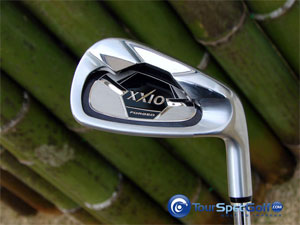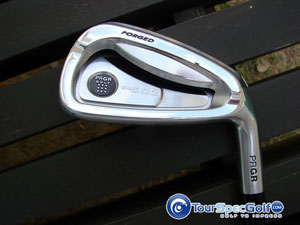Golf relies heavily on design and technology and exotic materials to push the envelope of performance. In recent years, many new high tech muti piece forgings have shunned traditionalists and their methods of forging the basic forged iron. Cutting edge manufacturers like Epon, XXIO, and most recently PRGR have spent lots of time and research on developing these new breeds or even hybrids of forging designs, moving away from the forged iron from a single billet of S20C or S25C steel.
Why have manufacturers decided to do this and what does it mean for the average golfer? The largest golfing group in Japan is classifed as the “average golfer” or what they call in the West, the “recreational golfer or weekend golfer”. This group of golfers probably makes up close to 80% of all the golfers in Japan so it is no surprise that many manufacturers gear many of their designs towards this customer group. The Japanese market is a very picky one and the Japanese only demand the best, and they are all willing to pay for it.
People always ask me, “Why are clubs much higher priced in Japan?” The fact is, pricing is dictated by the market and what the consumer is willing to pay for. Manufacturers set those prices based on numerous factors including, design, manufacturing process, materials and market demand. While a $750.00 driver is the very high end in the West, in Japan it is pretty much the norm. What this equals is conceivably a Japanese golfer who spends 3-4 times the amount of money on equipment as compared to a golfer in the US. They are willing to pay but in return they demand the best in design, materials and performance. Just like buying top notch and latest electronics in Akihabara Electric town, golf gear from Japan is expected to be cutting edge, premium quality and produce top notch results.
 Okay to get back on track here, irons is what we are talking about, Japanese manafacturers know that even the average golfer understands feel and quality when it comes to his golf clubs. Its all about the complete package when it comes to irons for the average golfer, not Game Improvement which is a term rarely used in Japan, but the complete performance package meaning, design, feel and performance. XXIO from Sri Sports, Epon Forged, and PRGR have decided that the traditional forged one piece iron, while definitely providing great feel didn’t necessarily meet the needs of the average golfer. These manufacturers went back to the drawing board and decided that they would create forged irons based on high tech designs and processes even if it meant using other materials besides soft carbon steel and even if it mean the iron itself would become more than one piece.
Okay to get back on track here, irons is what we are talking about, Japanese manafacturers know that even the average golfer understands feel and quality when it comes to his golf clubs. Its all about the complete package when it comes to irons for the average golfer, not Game Improvement which is a term rarely used in Japan, but the complete performance package meaning, design, feel and performance. XXIO from Sri Sports, Epon Forged, and PRGR have decided that the traditional forged one piece iron, while definitely providing great feel didn’t necessarily meet the needs of the average golfer. These manufacturers went back to the drawing board and decided that they would create forged irons based on high tech designs and processes even if it meant using other materials besides soft carbon steel and even if it mean the iron itself would become more than one piece.
Epon was one of the first to do it by releasing its AF-701 forged iron, a mid sized ultra performance cavity back iron that has not only been embraced by the average golfer in Japan but also the “athlete golfer”, the term in Japan for low handicapper, scratch golfer or simply darn good player. The AF-701 is an advanced multipiece forging from S20c steel for the neck body and undercut cavity matched with an AsRoll Steel face and tungsten weights forged into the sole.
 Why did Epon decide to use an AsRoll face? For a couple of reasons, durability and performance. The AsRoll steel is harder than the S20C body but does not feel that way because Epon is able to make the face thinner because of the stronger material. What this does is make the iron stronger and create higher ball speeds on impact. XXIO also released a new 2009 Forged multipiece iron this year with a soft forged S20C body but matched with a Chrome Vandium face. Once again the same concept applies, a thinner but stronger material still providing great feel but more ball speeds and a larger sweet spot. The new GN502 Forged from PRGR is the same idea with its nickel chrome molybdenum face and the PRGR is aimed at the athlete golfer.
Why did Epon decide to use an AsRoll face? For a couple of reasons, durability and performance. The AsRoll steel is harder than the S20C body but does not feel that way because Epon is able to make the face thinner because of the stronger material. What this does is make the iron stronger and create higher ball speeds on impact. XXIO also released a new 2009 Forged multipiece iron this year with a soft forged S20C body but matched with a Chrome Vandium face. Once again the same concept applies, a thinner but stronger material still providing great feel but more ball speeds and a larger sweet spot. The new GN502 Forged from PRGR is the same idea with its nickel chrome molybdenum face and the PRGR is aimed at the athlete golfer.
So far response from Japanese golfers have been tremendous. These irons provide not only forged feel, but amazing distance and forgiveness as well. The Japanese golfer is very technical and rather than saying, hey this iron is not “really” forged in the traditional sense, they look at the technology and say “wow this is a new type of forging that is amazing for my game”. The truth is these multi piece multi material forgings are more expensive and more labor intensive to make than their single piece counterparts. Golfers are now taking their games to the next level with irons that have been made to a new level.
I have tried the irons I mentioned above and they all feel great and perform great. There is definitely something for everyone in all these new iron designs. Golf equipment has come a long way and will only continue to evolve as manufacturers strive for ways to get ahead of one another. All that means is better gear for all of us.

